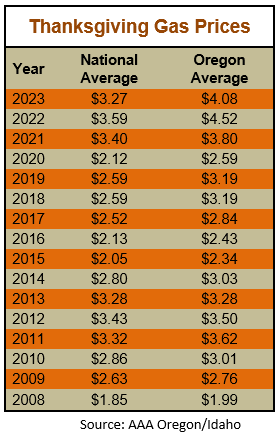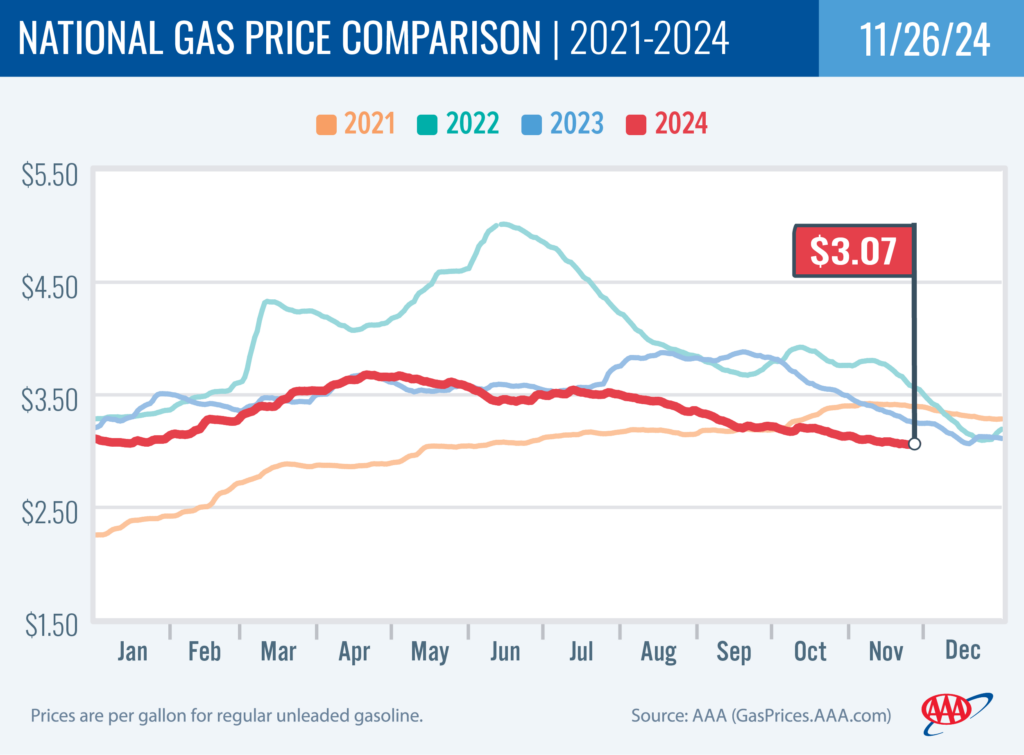Oregon, US gas prices tick upward ahead of Thanksgiving, AAA reports; still cheapest holiday travel since 2020

PORTLAND, Ore., (KTVZ) – Gas prices are edging up in about half of all states, including Oregon, ahead of Thanksgiving, AAA Oregon/Idaho said Tuesday. But drivers will still pay the cheapest prices for gas over the Thanksgiving holiday since 2020.
A jump in crude oil prices has put some upward pressure on pump prices, and West Coast prices were impacted by last week’s bomb cyclone. For the week, the national average for regular adds half a cent to $3.07 a gallon. The Oregon average gains three cents to $3.56 a gallon.
“Gas prices in the Pacific Northwest have seen small increases due to the bomb cyclone that pummeled the region last week. This led to concerns about power outages at refineries in the Puget Sound area, and fueled double-digit increases in wholesale gasoline prices in the region. We also saw crude oil prices rise about 6% last week, over concerns of an escalation in the war between Russia and Ukraine,” says Marie Dodds, public affairs director for AAA Oregon/Idaho. “Pump prices are settling down now and should resume declining soon, barring other unexpected events.”
Drivers are thankful for the cheapest gas prices for Thanksgiving since 2020. AAA projects record travel for the holiday with nearly 80 million Americans including 1.1 million Oregonians traveling for turkey. Car travel and air travel will set new records this year. Find all the details and tips for travelers in the AAA Thanksgiving news release.

The Oregon average began 2024 at $3.79 a gallon compared to $3.56 today. The lowest price so far in 2024 is $3.53 on November 19 and the highest is nearly $4.51 on May 1. The national average started the year at $3.11 and is at $3.07 today. The lowest price so far this year is just under $3.06 on November 24 and 25, and the highest is just under $3.68 on April 19.
This week, all Oregon counties have averages below $4 a gallon.
Gas prices typically drop in the fall, due to the switch from summer-blend to winter-blend fuel, which costs less to produce. The switch starts in September. Many areas, including Oregon, can sell winter-blend fuel starting September 15. However, Northern and Southern California require summer-blend fuel through October 31.
Meanwhile, crude oil production in the U.S. remains near the record high. The U.S. Energy Information Administration (EIA) reports that crude production in this country is at 13.2 million barrels per day for the week ending Nov.15. This is just under the record production of 13.5 million barrels per day, last reached on the week ending Nov. 1. The U.S. has been the top producer of crude oil in the world since 2018 and has been increasing its oil production since about 2009.
The U.S. price of crude oil (West Texas Intermediate) has been between about $67 and $74 per barrel since mid-October. Crude prices spiked 6% last week due to concerns of an escalation in the Russia-Ukraine war with the Kremlin talking of possible nuclear threats. Crude prices have settled down this week on optimism for a potential peace agreement between Israel and Hezbollah
Crude prices are impacted by economic news as well as geopolitical events around the world including the unrest in the Middle East and the war between Russia and Ukraine. In addition, production cuts by OPEC+ have tightened global crude oil supplies, which will continue to impact prices. Hurricane season can also impact crude oil prices, if a major storm impacts infrastructure in the Gulf of Mexico. Hurricane season runs from June 1 to November 30.
The price of crude oil reached the year-to-date high of nearly $87 per barrel on April 5. Major drivers of elevated crude prices have been the unrest in the Middle East, the decision by OPEC+ to keep oil production cuts in place, and war between Russia and Ukraine. Russia is a top global oil producer, behind the U.S. and Saudi Arabia.
Crude prices have been volatile after the attack on Israel by Hamas in October 2023. While Israel and the Palestinian territory are not oil producers, concerns remain that the conflict could spread in the Middle East, which could potentially impact crude production in other oil-producing nations in the region.
Crude oil is trading around $68 today compared to $68 a week ago and $78 a year ago. In 2023, West Texas Intermediate ranged between $63 and $95 per barrel. Crude reached recent highs of $123.70 on March 8, 2022, shortly after the Russian invasion of Ukraine, and $122.11 per barrel on June 8, 2022. The all-time high for WTI crude oil is $147.27 in July 2008.
Crude oil is the main ingredient in gasoline and diesel, so pump prices are impacted by crude prices on the global markets. On average, about 53% of what we pay for in a gallon of gasoline is for the price of crude oil, 11% is refining, 20% distribution and marketing, and 16% are taxes, according to the U.S. Energy Information Administration.
Demand for gasoline in the U.S. plunged from 9.38 million b/d to 8.41 million b/d for the week ending November 15, according to the U.S. Energy Information Administration (EIA). This compares to 8.48 million b/d a year ago. Meanwhile, total domestic gasoline stocks rose slightly from 206.9 million barrels to 208.9, while gasoline production decreased last week, averaging 9.3 million barrels daily.
As noted above, crude oil production in the U.S. slips from 13.4 million barrels per day to 13.2 million barrels per day, according to the EIA. The U.S. produces more crude oil than any other country, according to the EIA.
Pump prices should ease again, if crude oil prices don’t surge again.
Quick stats
Oregon is one of 24 states where prices are higher now than a week ago. Ohio (+11 cents) has the largest week-over-week increase in the nation. Maryland (-11 cents) has the biggest week-over-week drop.
Hawaii ($4.57) has the most expensive gas in the nation for the fourth week in a row. California ($4.44) is second, and Washington ($4.01) is third. Washington had dropped below the $4 mark last week, but crept above $4 again this week due to the bomb cyclone. This week 19 states and the District of Columbia have averages in the $3-range. There are 28 states with an average in the $2 range this week.
The cheapest gas in the nation is in Oklahoma ($2.52) and Mississippi ($2.63). No state has had an average below $2 a gallon since January 7, 2021, when Mississippi and Texas were below that threshold. At the time, the COVID-19 pandemic drove significant declines in crude oil and gasoline demand in the U.S. and around the world.
The difference between the most expensive and least expensive states is $2.05 this week, compared to $2.01 a week ago.
Oregon is one of 46 states and the District of Columbia with lower prices now than a month ago. The national average is seven cents less and the Oregon average is nine cents less than a month ago. Utah (-35 cents) has the largest month-over-month drop in the nation. Ohio (+10 cents) has the largest month-over-month increase.
Oregon is one of 48 states and the District of Columbia with lower prices now than a year ago. The national average is 19 cents less and the Oregon average is 49 cents less than a year ago. This is the second-largest year-over-year drop in the nation. Idaho (-53 cents) has the largest year-over-year decline. Georgia (+13 cents) and Florida (+10 cents) are the only states with year-over-year increases.
West Coast
The West Coast region continues to have the most expensive pump prices in the nation with all seven states in the top 10. It’s typical for the West Coast to have six or seven states in the top 10 as this region tends to consistently have fairly tight supplies, consuming about as much gasoline as is produced. In addition, this region is located relatively far from parts of the country where oil drilling, production and refining occurs, so transportation costs are higher. And environmental programs in this region add to the cost of production, storage and distribution.
| Rank | Region | Price on 11/26/2024 |
| 1 | Hawaii | $4.57 |
| 2 | California | $4.44 |
| 3 | Washington | $4.01 |
| 4 | Nevada | $3.70 |
| 5 | Oregon | $3.56 |
| 6 | Alaska | $3.48 |
| 7 | Pennsylvania | $3.25 |
| 8 | Illinois | $3.24 |
| 9 | District of Columbia | $3.24 |
| 10 | Arizona | $3.21 |
As mentioned above, Hawaii has the most expensive gas in the country for the fourth week in a row. California, Washington, Nevada, Oregon, and Alaska round out the top six. Arizona ($3.21) is 10th. Oregon is fifth for the 15th week in a row.
Four of the seven states in the West Coast region are seeing small declines in gas prices on the week:
Nevada (-3 cents), California (-2 cents), Alaska (-1 cent), and Hawaii (-2/10ths of a cent). Three of the seven states have small week-over-week increases: Arizona (+3 cents), Oregon (+3 cents), and Washington (+3 cents).
The refinery utilization rate on the West Coast rose from 87.1% to 89.6%for the week ending November 15. This rate has ranged between about 76% to 92% in the last year. The latest national refinery utilization rate decreased from 91.4% to 90.2%. The refinery utilization rate measures how much crude oil refineries are processing as a percentage of their maximum capacity. A low or declining rate can put upward pressure on pump prices, while a high or rising rate can put downward pressure on pump prices.
According to EIA’s latest weekly report, total gas stocks in the region dipped from 26.47 million bbl. to 26.39 million bbl.
An increase in the refinery utilization rate and/or a high rate can put downward pressure on pump prices, and a decrease in gasoline stocks can put upward pressure on pump prices.
Oil market dynamics
Crude oil prices rose about 6% last week, in part as markets reacted to geo-political jitters from Russia’s nuclear threats and the firing of a hypersonic missile at Ukraine by Russia in a warning to the U.S., Great Britain and other Western nations, following strikes by Ukraine on Russia using weapons provided by the U.S. and Great Britain. Prices have steadied to start this week. Meanwhile, the EIA reports that crude oil inventories increased by 0.5 million barrels from the previous week. At 430.3 million barrels, U.S. crude oil inventories are about 4% below the five-year average for this time of year.
At the close of Friday’s formal trading session, WTI added $1.14 to settle at $71.24. At the close of Monday’s formal trading session, WTI fell $2.30 to settle at $68.74. Today crude is trading around $68 compared to $69 a week ago. Crude prices are about $7 less than a year ago.
Drivers can find current gas prices along their route with the free AAA Mobile app for iPhone, iPad and Android. The app can also be used to map a route, find discounts, book a hotel and access AAA roadside assistance. Learn more at AAA.com/mobile.

Diesel
For the week, the national average ticks up one cent to $3.55 a gallon. The record high is $5.816 set on June 19, 2022. The Oregon average slips one cent to $3.85. The record high is $6.47 set on July 3, 2022. A year ago the national average for diesel was $4.24 and the Oregon average was $4.65.
Find current fuel prices at GasPrices.AAA.com.